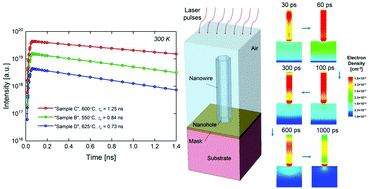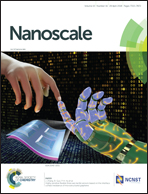Exploring time-resolved photoluminescence for nanowires using a three-dimensional computational transient model†
Abstract
Time-resolved photoluminescence (TRPL) has been implemented experimentally to measure the carrier lifetime of semiconductors for decades. For the characterization of nanowires, the rich information embedded in TRPL curves has not been fully interpreted and meaningfully mapped to the respective material properties. This is because their three-dimensional (3-D) geometries result in more complicated mechanisms of carrier recombination than those in thin films and analytical solutions cannot be found for those nanostructures. In this work, we extend the intrinsic power of TRPL by developing a full 3-D transient model, which accounts for different material properties and drift-diffusion, to simulate TRPL curves for nanowires. To show the capability of the model, we perform TRPL measurements on a set of GaAs nanowire arrays grown on silicon substrates and then fit the measured data by tuning various material properties, including carrier mobility, Shockley–Read–Hall recombination lifetime, and surface recombination velocity at the GaAs–Si heterointerface. From the resultant TRPL simulations, we numerically identify the lifetime characteristics of those material properties. In addition, we computationally map the spatial and temporal electron distributions in nanowire segments and reveal the underlying carrier dynamics. We believe this study provides a theoretical foundation for interpretation of TRPL measurements to unveil the complex carrier recombination mechanisms in 3-D nanostructured materials.



 Please wait while we load your content...
Please wait while we load your content...